Jonathan Erdman
The count of billion-dollar weather disasters in the United States so far in 2023 already smashed a record for any year, according to a new government report.
NOAA's August national climate report released Monday found that 23 weather events caused at least $1 billion in damage in the U.S. this year, one more than the record for any year of 22 set in 2020.
Among these 23 costly events were 18 separate rounds of severe thunderstorms and tornadoes from March through August primarily in the southern and central U.S., a pair of floods, a hurricane, a wildfire and a winter cold snap, NOAA detailed.
The tally of such disasters so far in 2023 was also seven more than any previous first eight months of any year, NOAA said. Record-keeping for billion-dollar disasters in the U.S. dates back to 1980.
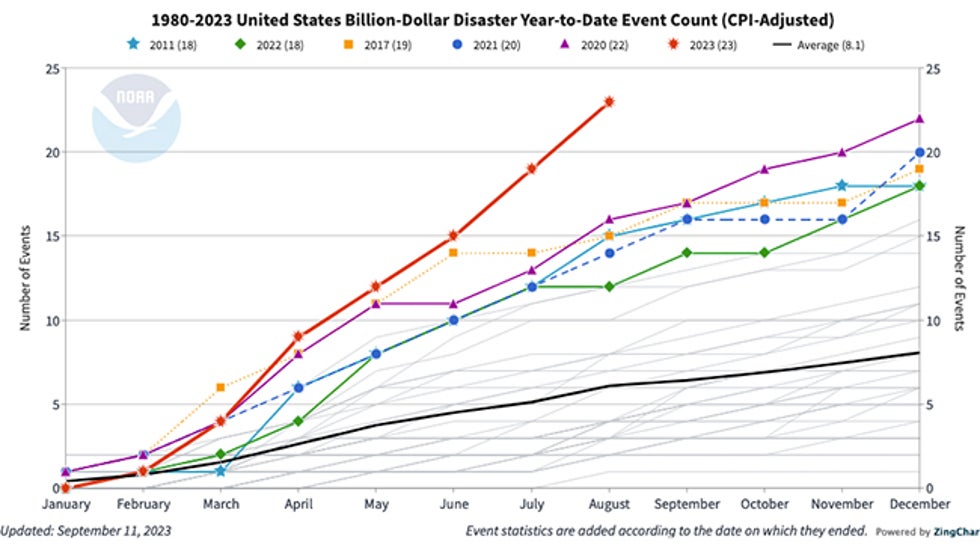 The year-to-date count of billion-dollar weather disasters in the U.S. The red line shows 2023's pace through August, higher than the previous January-August and any full year (2020), which is shown in purple. The long-term 1980-2022 average is shown by the black line.
The year-to-date count of billion-dollar weather disasters in the U.S. The red line shows 2023's pace through August, higher than the previous January-August and any full year (2020), which is shown in purple. The long-term 1980-2022 average is shown by the black line.The combined total of these 2023 disasters is over $57.6 billion. That trails only 2005 ($202.7 billion) and 2017 ($184.4 billion) for the total damage toll through the first eight months of any year since 1980, according to NOAA.
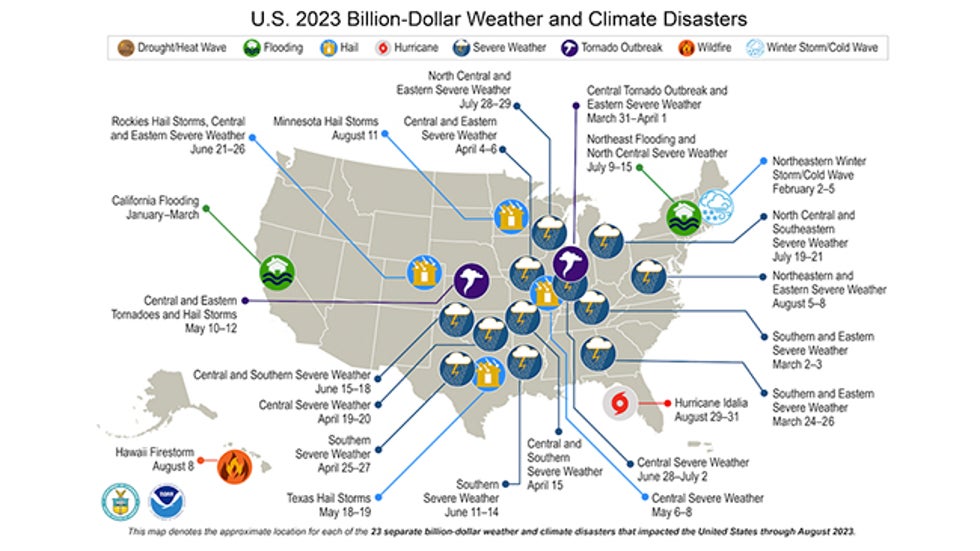 The 23 billion-dollar weather disasters in 2023, from January through August.
The 23 billion-dollar weather disasters in 2023, from January through August.Here is NOAA's list of these 23 disasters, in chronological order, along with their latest damage estimates.
1. California Flooding ($4.6 billion): A parade of Pacific storms began just after Christmas 2022 and lasted into March, dumping flooding rain in parts of Northern California and the Central Valley, as well as feet of record snowfall in parts of the Sierra and Southern California high country.
2. Northeast Cold Wave ($1.8 billion): A blast of bitterly cold air swept through the Northeast in early February. High winds downed trees and power lines, particularly in New England. In parts of northern Maine, water in trees froze and expanded, causing them to split. This cold outbreak also set a wind chill record of minus 108 degrees at the Mount Washington Observatory in New Hampshire.
3. South, East Severe Weather Outbreak ($6.1 billion): A rash of severe thunderstorms and tornadoes swept through parts of the Southern Plains, Southeast and Ohio Valley March 2-3. At least 33 tornadoes were confirmed by the National Weather Service, including EF2 tornadoes near Kirby, Arkansas, and Fremont, Kentucky. Wind gusts from 70 to 90 mph hammered the Dallas-Fort Worth metro.
4. South, East Severe Weather Outbreak II ($2.7 billion): Tornadoes tore across parts of the Southeast March 24-26, including Rolling Fork, Silver City, Tchula, Winona and Amory, Mississippi, claiming 21 lives in Mississippi and another in Alabama. An EF3 tornado ripped through parts of Troup County, Georgia. Damaging winds also swept through parts of Ohio, western Pennsylvania and West Virginia.
5. Central, Eastern Tornado Outbreak ($5.4 billion): At least 145 tornadoes, along with damaging thunderstorm winds, tore through large swaths of the Midwest, Tennessee Valley and East from March 31 through April 1. Among those was an EF3 tornado in the Little Rock, Arkansas, metro area; deadly tornadoes in McNairy County, Tennessee, and Sullivan County, Indiana; and Delaware's widest tornado on record.
6. Midwest, East Severe Weather Outbreak ($2.8 billion): At least 35 tornadoes, along with damaging thunderstorm winds, once again swept through parts of the Midwest and East April 4-6. That included an early-morning EF2 tornado near Bollinger, Missouri, which claimed five lives.
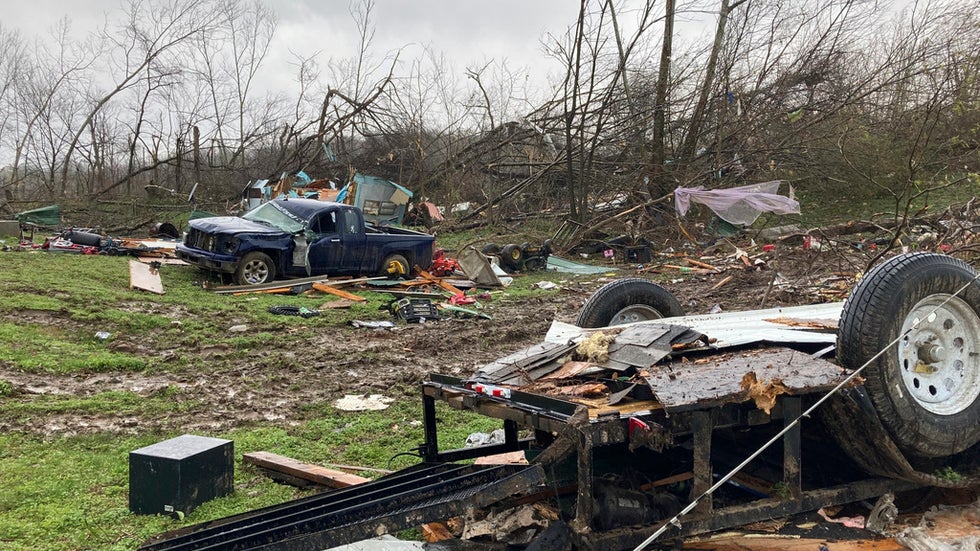 Devastation from a tornado that hit the Glenallen community in southeastern Missouri, killing five people, is pictured on Wednesday, April 5, 2023.
Devastation from a tornado that hit the Glenallen community in southeastern Missouri, killing five people, is pictured on Wednesday, April 5, 2023.7. Mid-April Severe Weather ($1.3 billion): Severe thunderstorms with destructive winds, hail and a few tornadoes hammered areas from the Florida Panhandle to the mid-Mississippi Valley, including parts of the St. Louis metro area, on April 15.
8. Mid-April Severe Weather II ($2.8 billion): This two-day severe weather event from the Plains to the upper Midwest spawned tornadoes in central Oklahoma on April 19 including a deadly EF3 tornado in McClain County and another in the city of Shawnee. Hail larger than baseballs was reported in the Dallas-Fort Worth metro area on April 20.
9. Late April Severe Weather ($1.1 billion): Severe thunderstorms rumbled from parts of Texas to Florida from April 25-27. This included a number of destructive hailstorms in Texas, one of which damaged over 100 vehicles in Rusk County.
10. Early May Severe Weather ($1.8 billion): Severe thunderstorms with tennis ball or larger hail and a few tornadoes swarmed over parts of the Missouri Valley, mid-Mississippi Valley and Texas from May 6-8.
11. Mid-May Severe Weather ($2.8 billion): Severe thunderstorms with several tornadoes and large hail occurred in the Plains from parts of Nebraska to Colorado to Texas.
12. Texas Hailstorms ($1.6 billion): Up to tennis-ball-sized hail was dumped on parts of north-central Texas, including the Dallas-Fort Worth metro area on May 19.
13. Mid-June South Severe Weather ($2.6 billion): Clusters of severe thunderstorms from June 11-14 swarmed over parts of the South, from New Mexico and Texas to the Southeast. These storms produced more giant hailstones, some the size of grapefruit or larger, in parts of Texas and Mississippi. It also produced a swarm of wind damage throughout the Deep South from Arkansas and northern Louisiana to Georgia and northern Florida.
14. Mid-June Southern Severe Weather II ($3.1 billion): Another multi-day severe weather siege, unusual for mid-June in the Deep South, hammered areas from Oklahoma and Texas to Georgia and Florida. Over 70 tornadoes were confirmed, including EF3 twisters in Louin, Mississippi, and Perryton, Texas. What was likely a derecho roared from Kansas and western Oklahoma to Florida June 15-16, with damaging gusts over 75 mph in spots.
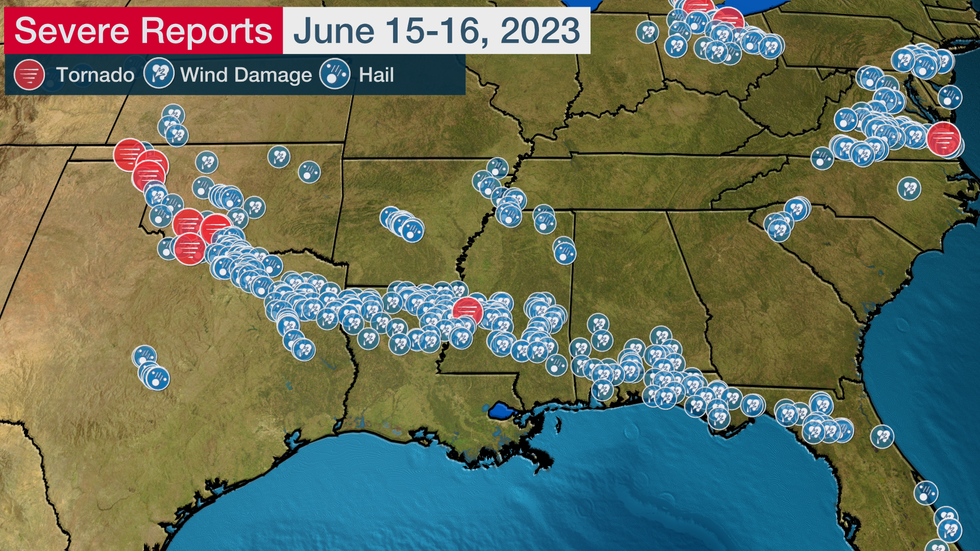 These were preliminary storm reports from severe thunderstorms on June 15-16, 2023. The number of preliminary tornado reports plotted above, therefore, doesn't necessarily correlate to the number of actual tornadoes, later confirmed by NWS storm surveys.
These were preliminary storm reports from severe thunderstorms on June 15-16, 2023. The number of preliminary tornado reports plotted above, therefore, doesn't necessarily correlate to the number of actual tornadoes, later confirmed by NWS storm surveys.15. Late June Severe Weather ($3.5 billion): This siege of storms from June 21-26 began in the High Plains, including destructive hailstorms in Colorado, one of which injured almost 100 concertgoers near Denver, and a deadly tornado in Matador, Texas. It eventually spread into the Midwest and East from June 24-26 with over 700 reports of high winds or wind damage from thunderstorms.
16. Late June - Early July Severe Weather ($1.2 billion): This multi-day round of severe thunderstorms produced destructive winds in parts of the Plains, Midwest and East from June 28 through July 2, along with a few tornadoes. Kentucky, Illinois, Indiana and Missouri were among the hardest hit states on multiple days.
17. July Northeast Flood ($2.1 billion): Devastating flash flooding swamped parts of the Northeast, specifically Vermont and parts of New York state into northeast Pennsylvania and northwest Connecticut. Thousands of homes and businesses were damaged when flooding swamped downtown Montpelier, Vermont, and other towns in the state. Almost 7 inches of rain in three hours trapped vehicles and washed out roads around the U.S. Military Academy at West Point.
18. Mid-July Severe Weather ($1.2 billion): This swarm of severe thunderstorms produced numerous reports of damaging winds from the Great Lakes into parts of the Northeast and Southeast from July 19-21. These wind damage reports were highest in Michigan, Ohio, western New York, Pennsylvania, Tennessee and Georgia.
19. Late July Severe Weather ($1.2 billion): Just one week later, another rash of severe thunderstorms produced over 800 reports of high winds or damaging thunderstorm winds from the Plains and Midwest to the mid-Atlantic and Southeast from July 28-29.
20. Early August East Severe Weather ($1.3 billion): This siege of severe weather in early August culminated on Aug. 7 with the nation's most reports of severe thunderstorms (766) of any 24-hour period so far in 2023. Most of those were damaging thunderstorms winds in the mid-Atlantic states and Southeast. That also included a rare EF3 tornado in New York's Tug Hill Plateau.
21. Lahaina Firestorm ($5.5 billion): Fanned by strong winds and drought conditions, wildfires devastated the town of Lahaina on Maui, Hawaii, on Aug. 8. At least 115 were confirmed killed in the nation's deadliest wildfire in over 100 years. The fire consumed thousands of homes, businesses and vehicles.
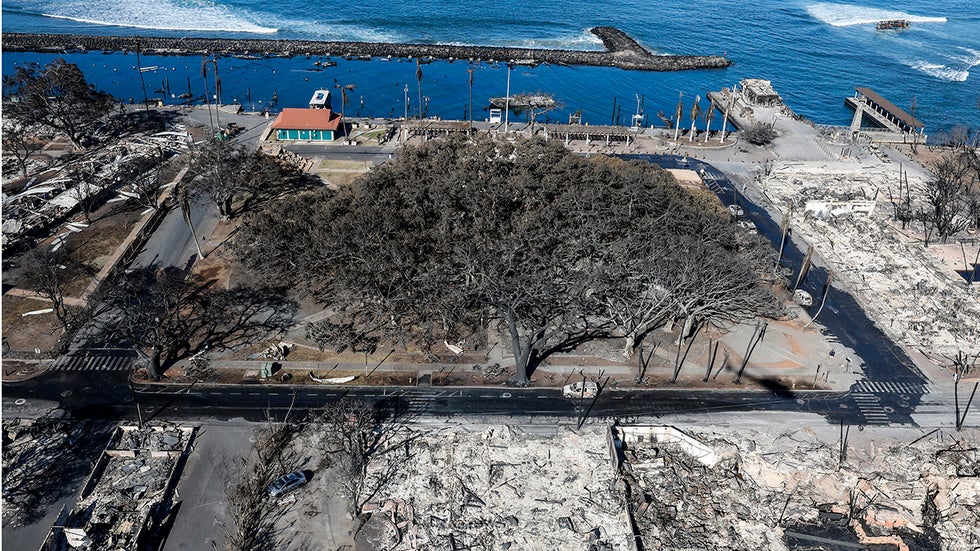 The iconic Banyan tree stands among the rubble of burned buildings days after a catastrophic wildfire swept through the city of Lahaina, Hawaii, on the island of Maui.
The iconic Banyan tree stands among the rubble of burned buildings days after a catastrophic wildfire swept through the city of Lahaina, Hawaii, on the island of Maui.22. Minnesota Hail ($1.1 billion): This flareup of severe weather produced swaths of hail locally over baseball size and driven by strong thunderstorm winds across central Minnesota, including parts of the Minneapolis-St. Paul metro area, on Aug. 11. Roofs and siding of homes were damaged, as were vehicles.
23. Hurricane Idalia (to be determined): Idalia swept ashore at Category 3 intensity, tied as the strongest hurricane landfall on record for Florida's Big Bend region on Aug. 30. Surge up to almost 9 feet was documented in Cedar Key, where homes, businesses and vehicles were inundated. Damaging wind gusts penetrated inland into north Florida and southern Georgia, downing trees on homes. Over 10 inches of rain triggered flash flooding, along with coastal flooding, as far north as the eastern Carolinas.
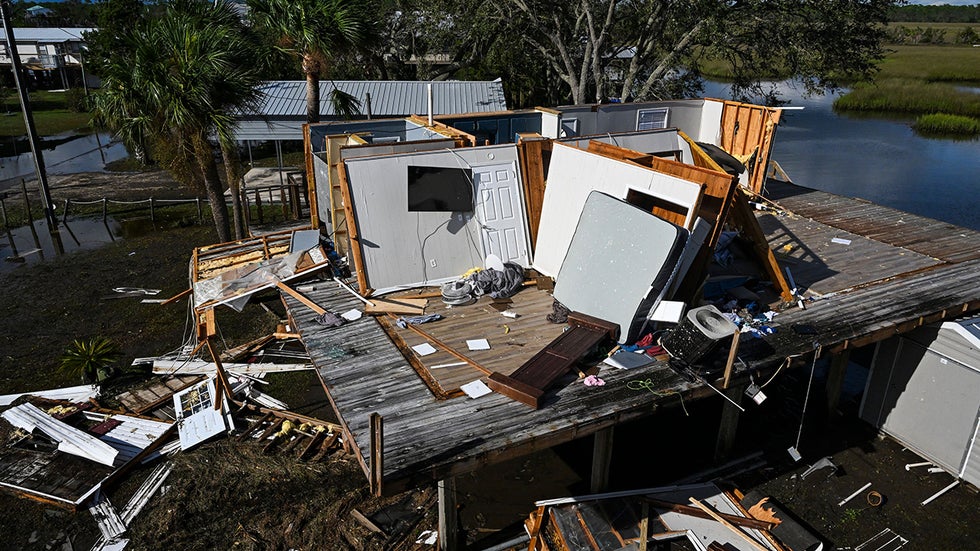 A destroyed house is seen in Keaton Beach, Florida, on Aug. 30, 2023, after Hurricane Idalia made landfall. Idalia slammed into northwest Florida as an "extremely dangerous" Category 3 storm early Wednesday, buffeting coastal communities with cascades of water as officials warned of "catastrophic" flooding in parts of the state.
A destroyed house is seen in Keaton Beach, Florida, on Aug. 30, 2023, after Hurricane Idalia made landfall. Idalia slammed into northwest Florida as an "extremely dangerous" Category 3 storm early Wednesday, buffeting coastal communities with cascades of water as officials warned of "catastrophic" flooding in parts of the state.This list may grow. If that wasn't enough, NOAA also mentioned two other events – flooding from Tropical Storm Hilary in August in the Southwest and the ongoing South and Midwest drought – could add to the billion-dollar list, once those calculations are made.
The costliest year was 2017. While just 19 billion-dollar disasters occurred in 2017, they accounted for an estimated $383.7 billion in damage, most of any year since 1980. Hurricanes Harvey, Irma, and Maria were responsible for 86% of that damage tally in 2017.
Severe thunderstorm events are most frequent. According to NOAA's statistics, there have been 185 severe thunderstorm events that have caused at least $1 billion in damage in the U.S. from 1980 through August 2023. That's an average of four such events each year.
Recent plague of billion-dollar disasters: The past three years have had a combined 60 billion-dollar disasters, the most of any three-year period in NOAA records dating to 1980. That included 13 to 14 severe thunderstorm billion-dollar events each year from 2020 through 2022.
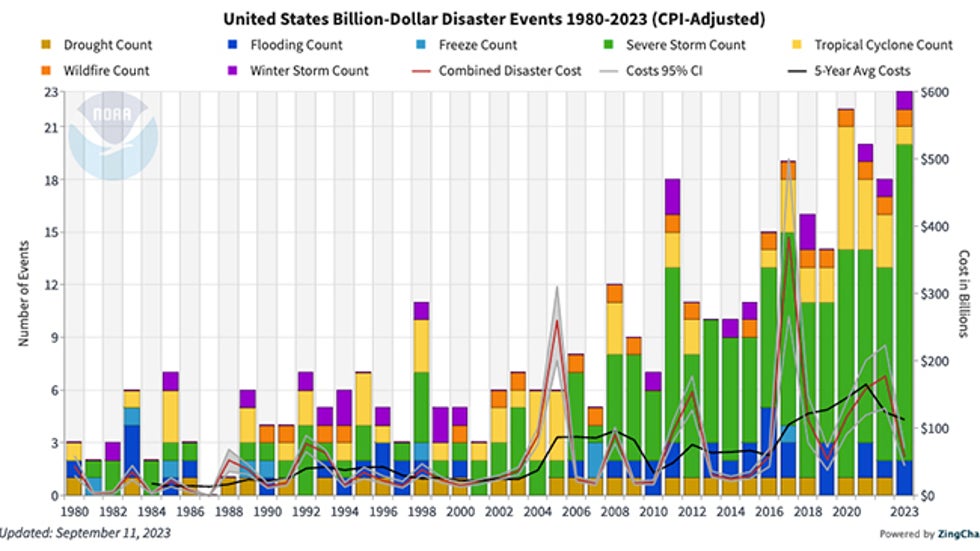 Yearly tally of U.S. weather disasters that caused at least $1 billion in damage from 1980 through 2023, color-coded by type of weather event. Cost estimations are adjusted for inflation to 2023.
Yearly tally of U.S. weather disasters that caused at least $1 billion in damage from 1980 through 2023, color-coded by type of weather event. Cost estimations are adjusted for inflation to 2023.Hurricanes and tropical storms are costliest. Since 1980, America's costliest weather disasters have almost exclusively been hurricanes. For example, 2005's Hurricane Katrina's damage toll – adjusted for inflation to 2023 dollars – was $195 billion, over three times the total of all of 2023's disasters so far. Last year, Hurricane Ian inflicted an estimated $115.2 billion in damage.
Jonathan Erdman is a senior meteorologist at weather.com and has been covering national and international weather since 1996. His lifelong love of meteorology began with a close encounter from a tornado as a child in Wisconsin. He studied physics at the University of Wisconsin-Madison, then completed his Master's degree working with dual-polarization radar and lightning data at Colorado State University. Extreme and bizarre weather are his favorite topics. Reach out to him on X/Twitter, Facebook and Threads.
The Weather Company’s primary journalistic mission is to report on breaking weather news, the environment and the importance of science to our lives. This story does not necessarily represent the position of our parent company, IBM.
The Weather Company’s primary journalistic mission is to report on breaking weather news, the environment and the importance of science to our lives. This story does not necessarily represent the position of our parent company, IBM.

No comments:
Post a Comment